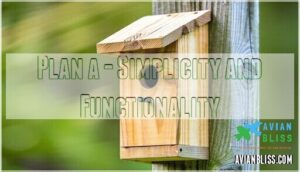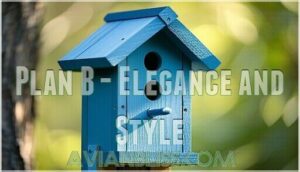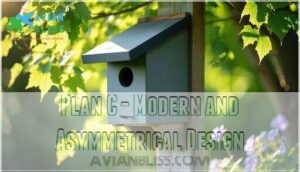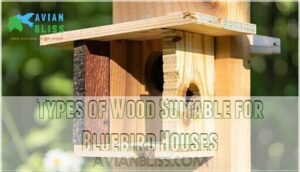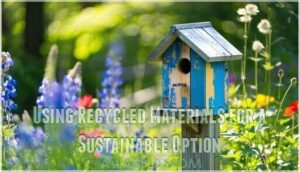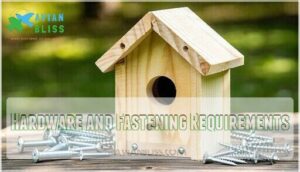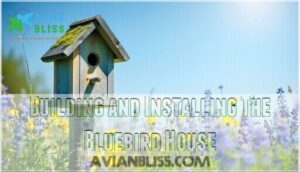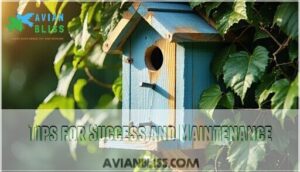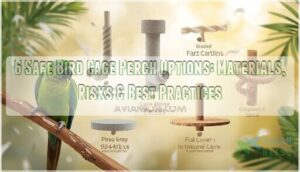This site is supported by our readers. We may earn a commission, at no cost to you, if you purchase through links.
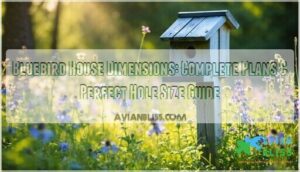 You’ll need specific bluebird house dimensions to attract these colorful birds successfully.
You’ll need specific bluebird house dimensions to attract these colorful birds successfully.
Build your house with a 4" x 4" interior floor and 9" height from floor to ceiling.
The entrance hole should be exactly 1½ inches in diameter, positioned 6-10 inches from the bottom.
This precise sizing keeps starlings and larger birds out while giving bluebirds enough room to raise their families.
Add ventilation holes near the top and drainage holes in the floor bottom.
These measurements aren’t random—they’re based on decades of research into what makes bluebirds feel secure and comfortable when choosing nesting sites.
Table Of Contents
- Key Takeaways
- Essential Dimensions and Features
- Designing The Perfect Bluebird House
- Choosing The Right Materials
- Building and Installing The Bluebird House
- Tips for Success and Maintenance
- Frequently Asked Questions (FAQs)
- When Should I Put Up a Bluebird House?
- Which Way Should Bluebird House Face?
- How High From the Ground Should a Bluebird House be Mounted?
- Can I Mount a Bluebird House on a Tree?
- What is the ideal size for a bluebird house?
- How do you attract bluebirds to a bluebird house?
- Can I put a bluebird house on a tree?
- How big should a Bluebird house be?
- How to choose the right size for a bluebird house?
- How big should a Bluebird hole be?
- Conclusion
Key Takeaways
- Build with precise 4" x 4" floor dimensions and 9" height – You’ll need these exact measurements to give bluebirds enough space while preventing overcrowding that affects nesting success.
- Create a 1½-inch entrance hole positioned 6-8 inches from the floor – This specific size keeps starlings out while allowing bluebirds safe entry and exit for fledglings.
- Install proper ventilation and drainage systems – You’ll want ¾-inch ventilation gaps near the top and ¼-inch drainage holes in floor corners to prevent moisture buildup and maintain healthy nesting conditions.
- Mount 4-6 feet high on smooth poles with predator baffles – You’ll protect nesting birds from climbing predators like raccoons and snakes while maintaining easy monitoring access.
Essential Dimensions and Features
Getting the dimensions right is what separates a bluebird’s dream home from just another empty box in your yard.
You’ll need to nail down the floor space, entrance hole size, and ventilation details to create a house that actually attracts these beautiful birds and keeps them safe from predators, which is crucial for making it a bluebird’s dream home.
Minimum Interior Floor Space
When building a bluebird house, your floor dimensions directly impact nesting success.
Right dimensions mean the difference between empty boxes and happy bluebird families.
The minimum interior floor size should be 4×4 inches, though 5×5 inches works better for thermal regulation.
Proper floor dimensions guarantee nesting comfort and fledgling success, while species variation matters—Mountain Bluebirds prefer larger spaces than Eastern varieties.
- Floor Size Impact: Adequate space prevents overcrowding and allows proper nest development
- Thermal Regulation: Larger floors help maintain stable temperatures during extreme weather
- Fledgling Success: Sufficient room gives young birds space to develop flight muscles before leaving
Entry Hole Size and Position
Your bluebird house entrance hole determines who moves in. Set a 1½-inch diameter for Eastern Bluebirds—this keeps starlings out while welcoming your feathered friends. Position it 5-6 inches above the floor so fledglings can exit safely.
The right entrance hole size is your first line of defense against unwanted houseguests.
Here’s your entrance hole checklist:
- Diameter: 1½ inches for Eastern Bluebirds, 1 9/16 inches for Mountain Bluebirds
- Height: 5-6 inches from floor to bottom of hole
- Shape: Round holes work best for starling deterrents
- Guards: Add predator guards around the entrance
- Smoothing: Sand rough edges to prevent injury
Hole height matters—too low invites predators, too high makes fledgling exit difficult. The right bluebird house entrance hole size creates a safe haven that attracts the right species variation while keeping unwanted visitors away. Bluebird houses should be cleaned annually to guarantee a healthy habitat for nesting.
Roof and Ventilation Requirements
When designing your bluebird house roof, focus on creating a slanted roof with proper roof overhang extending at least 2 inches beyond the front. Choose weather-resistant roof materials like cedar or recycled plastic for durability.
- Install ventilation gaps (¾ inch) at the top of side walls for temperature control
- Add drainage holes in floor corners to prevent water accumulation and maintain dry conditions
To further protect bird health, make certain proper air circulation to prevent mold.
Drainage and Mounting Considerations
Two key factors protect your feathered friends: proper drainage and smart mounting choices.
Drill 1/4-inch drainage holes in each floor corner to prevent water buildup that could harm nestlings.
Mount your house 4-6 feet high on a smooth pole with predator baffles – never on trees where raccoons can easily climb.
| Feature | Specification | Purpose |
|---|---|---|
| Drainage Holes | 1/4-inch diameter, one per corner | Prevents water accumulation |
| Mounting Height | 4-6 feet above ground | Ideal access and safety |
| Pole Materials | PVC or metal with smooth surface | Deters climbing predators |
| Predator Baffles | Required below house | Blocks snakes and mammals |
| Spacing Houses | 300+ feet apart minimum | Reduces territorial conflicts |
Designing The Perfect Bluebird House
You’ll want to choose from three proven bluebird house designs that balance functionality with ease of construction.
Each plan offers different benefits, from basic weatherproofing to elegant aesthetics, so you can match your woodworking skills with your backyard’s style.
Plan a – Simplicity and Functionality
When you want a no-fuss approach to attracting bluebirds, Plan A delivers exactly what these birds need.
This Classic Design features a Sloped Roof for Water Runoff and represents the most Effective Housing solution you’ll find.
Here’s what makes this Simple Build perfect:
- Single forward-angled roof prevents water pooling
- Minimal cuts from one cedar board reduce construction time
- Proven bluebird house dimensions maximize nesting success
The house can be mounted using pipe U-bolts on a T-post.
Plan B – Elegance and Style
Plan B combines dual-sloped roof elegance with practical function for your stylish birdhouse. This shaded design features two angled roof sections that create elegant aesthetics while protecting nests from rain and harsh sun.
Your bluebird house dimensions remain standard—4×4 to 5×5 inch floors—but the unique materials and sophisticated rooflines elevate this nest box beyond basic designs.
Ideal designs often include essential drainage holes to prevent nestling health risks.
Plan C – Modern and Asymmetrical Design
Modern asymmetrical bluebird house designs break traditional molds while maintaining essential bluebird house dimensions.
These contemporary nest box designs showcase Asymmetrical Aesthetics with flat roofs and Unique Materials like recycled plastics.
Key features include:
- Roof Innovation with angular lines for water drainage
- Modern Ventilation systems integrated into the design
- Weather-resistant composite materials for longevity
- Design Challenges balanced with functional requirements
Choosing The Right Materials
You’ll need the right materials to build a bluebird house that lasts for years and keeps birds safe.
Cedar, redwood, and recycled plastic offer the best durability, while proper hardware guarantees your house stays secure through all weather conditions.
Types of Wood Suitable for Bluebird Houses
Cedar stands out for bluebird house materials with exceptional cedar durability and natural decay-resistant wood properties.
Redwood benefits include superior weather resistance and longevity.
Pine alternatives offer affordability but need more maintenance than premium woods.
Avoid exterior plywood due to plywood concerns about warping and deterioration.
Always choose untreated wood to protect your feathered friends from harmful chemicals.
A natural cedar finish can further enhance longevity.
Using Recycled Materials for a Sustainable Option
Recycled wood from old fences or pallets works great for bluebird house dimensions when properly cleaned and checked for safety.
Recycled plastic offers excellent durable materials that won’t warp or rot, making it perfect for sustainable design.
These ecofriendly options reduce costs while creating environmentally responsible homes that maintain proper bluebird house dimensions for years.
Hardware and Fastening Requirements
Your bluebird house’s durability depends on choosing quality hardware that won’t fail when it matters most.
Select galvanized wood screws for bluebird house construction to prevent fastener corrosion, ensuring material compatibility with your chosen wood.
For a variety of options, consider purchasing screws online.
Use rust-resistant metal hinges for monitoring access and sturdy roof brackets for bracket stability.
Quality bluebird house screws and proper cutting tools make bluebird house building straightforward while maintaining precise bluebird house dimensions for years of reliable use.
Building and Installing The Bluebird House
Now you’re ready to bring your bluebird house plans to life with proper construction techniques.
Follow these steps to create a safe, functional home that bluebirds will love using for years to come.
Cutting and Assembling The Pieces
With your materials ready, start cutting accuracy by measuring twice and cutting once. Follow your bluebird house plans carefully for proper bluebird house dimensions.
Cut all pieces before starting assembly order – front, back, sides, floor, and roof. Secure fastening with wood screws guarantees joint strength throughout nest box construction.
Pre-drill holes to prevent splitting. Consider appropriate screw sizes for maximum hold.
Weatherproofing seams comes next, but focus on precise cuts now for successful bluebird house construction.
Drilling Entrance Holes and Ventilation
Proper drilling transforms your assembled pieces into a functional home. A 1½-inch hole diameter works perfectly for Eastern Bluebirds, while Mountain Bluebirds need 1 9/16 inches for their entrance hole size.
Position the bluebird house entrance hole 6-8 inches above the floor, centering it carefully for ideal hole placement.
Ventilation gaps guarantee healthy airflow:
- Drill ¼-inch holes under the roof for proper bluebird house ventilation
- Add drainage holes in floor corners for moisture control
- Consider predator guards around entrance holes for protection
Mounting and Placement Principles
With your entrance holes perfectly drilled, pole installation becomes your next priority.
Mount your bluebird house 4-6 feet high on a smooth metal pole to prevent climbing predators from reaching the nest.
Baffle effectiveness depends on proper installation – attach an 18-inch diameter baffle below the box.
Choose an open area with short grass, positioning the facing direction east or southeast to shield from harsh afternoon sun.
Spacing guidelines require 100 yards between houses to prevent territorial disputes.
To further enhance the environment, consider sunny open locations for the birdhouse.
Consider habitat considerations like nearby perching spots 25-100 feet away for fledglings.
Proper bluebird house placement and mounting in suitable habitat increases your chances of attracting these beautiful birds to your yard.
Tips for Success and Maintenance
Building your bluebird house is just the beginning – proper maintenance and smart placement guarantee your feathered friends return year after year.
You’ll need to monitor for unwanted guests, space houses correctly, and orient them for maximum success.
Monitoring for Pests and Predators
Once your bluebird house is installed, regular monitoring becomes your best defense against unwanted visitors.
Check nest boxes weekly during breeding season to spot trouble early.
Common threats you’ll encounter:
- Raccoons and opossums – These clever climbers destroy eggs and nestlings, especially during second broods
- Insect infestations – Blowfly larvae weaken chicks while mites create unhealthy conditions
- House sparrows – These aggressive birds pierce eggs and kill young bluebirds
Install predator deterrents like stovepipe baffles and Noel Guards for solid predator protection.
Regular checks will aid in effective nest surveillance.
Clean boxes between broods with boiling water for effective parasite control.
Maintaining The Right Distance Between Houses
Surprisingly, many bluebird enthusiasts overlook proper house spacing, leading to fierce territorial disputes.
You’ll need strategic spacing strategies to prevent territorial overlap and guarantee successful nesting. Position houses at least 100 yards apart for maximum competition reduction and bluebird behavior management.
| Distance | Outcome |
|---|---|
| 50-70 yards | Territorial conflicts likely |
| 100+ yards | Peaceful coexistence achieved |
| 300+ yards | Maximum nesting success |
This habitat density approach transforms bluebird house placement from guesswork into science, creating harmonious nesting communities.
Facing The Right Direction for Optimal Results
Your bluebird house placement affects nesting success dramatically.
Face east for gentle morning Sun Exposure while avoiding harsh afternoon heat.
Consider these factors:
- Wind Direction – Shield from prevailing winds
- Regional Climate – Adjust for local weather patterns
- Predator Avoidance – Clear sightlines for escape routes
- Local Landscape – Open areas with nearby perches
Smart bluebird house mounting creates comfortable homes.
Frequently Asked Questions (FAQs)
When Should I Put Up a Bluebird House?
You’ll want to install your bluebird house by March, though February works even better.
Bluebirds start scouting for nesting spots early, so getting ahead of their house-hunting season gives them time to discover and claim your box.
Which Way Should Bluebird House Face?
Face your bluebird house opening toward the east for ideal morning sun and protection from harsh afternoon heat.
North is your second-best choice, followed by south or west orientations for comfortable nesting conditions.
How High From the Ground Should a Bluebird House be Mounted?
Ever wondered what’s the sweet spot for mounting your nest box?
You’ll want to position your bluebird house 4-6 feet above ground on a smooth pole with baffles to keep those sneaky predators from climbing up and disturbing your feathered friends, which is the key to a successful and safe nest.
Can I Mount a Bluebird House on a Tree?
You shouldn’t mount bluebird houses on trees because predators like cats, raccoons, and snakes can easily climb up and raid the nest, putting eggs and baby birds at risk.
What is the ideal size for a bluebird house?
The proof’s in the pudding with bluebird houses – you’ll want a floor that’s 4×4 to 5×5 inches with 9-12 inch interior height.
A 5-inch entrance hole sits 6 inches above the floor for perfect fledgling access, which is a complete concept for the house design.
How do you attract bluebirds to a bluebird house?
Place your house in open areas with short grass.
Mount it 4-6 feet high on a pole with a predator baffle.
Make certain proper drainage and ventilation for successful nesting.
Can I put a bluebird house on a tree?
No, don’t mount bluebird houses on trees. This allows predators like snakes, raccoons, and cats easy access to attack nests. Instead, use smooth poles with baffles for protection.
How big should a Bluebird house be?
Bluebirds need surprisingly specific dimensions—just one inch too big attracts unwanted house sparrows.
Your bluebird house should measure 4×4 to 5×5 inches for the floor, with 9-12 inches interior height and a 5-inch entrance hole positioned 5-6 inches above the floor.
How to choose the right size for a bluebird house?
Choose a floor size between 4×4 and 5×5 inches for ideal comfort.
You’ll want 9-12 inches of interior height with a 5-inch entrance hole positioned 5-6 inches above the floor for safe fledging.
How big should a Bluebird hole be?
While tiny sparrows need massive holes, you’ll want precision for bluebirds.
Make the entrance hole exactly 1½ inches in diameter—this keeps out larger competitors like starlings while welcoming your feathered friends home safely.
Conclusion
Like a blueprint guiding every nail and board, getting your bluebird house dimensions right makes the difference between success and empty boxes.
You’ve learned the exact measurements—4" x 4" floor, 9" height, and that vital 1½-inch entrance hole.
These aren’t just numbers; they’re your recipe for attracting bluebirds while keeping competitors out.
Follow these proven dimensions, add proper ventilation and drainage, and you’ll create the perfect home these beautiful birds can’t resist choosing for their families.
- https://www.nabluebirdsociety.org/PDF/NABS%20factsheet%20-%20Nestbox%20Recs.pdf
- https://georgiawildlife.com/out-my-backdoor-whats-best-bluebird-box-design
- https://kmwoodworking.com/products/super-bluebird-nest-box
- https://coveside.com/products/coveside-sparrow-resistant-eastern-bluebird-house
- https://www.audubon.org/news/diy-build-bluebird-box

